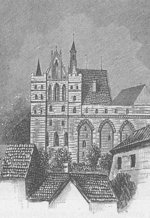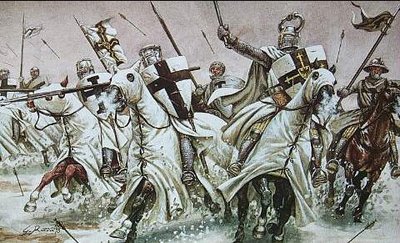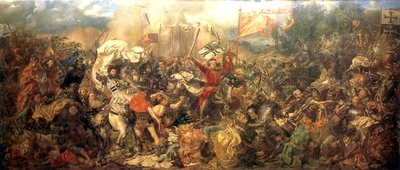Teutonic Knights
|
|
The Teutonic Order (German: Deutscher Orden; Latin: Ordo domus Sanctæ Mariæ Theutonicorum) was a German crusading military order under Roman Catholic religious vows which was formed at the end of the 12th century in Acre (Akko) in Palestine to give medical aid to pilgrims to the holy places. They wore white coats with a black cross. After Christian forces were defeated in the Middle East, in 1211 they moved to Transylvania, from where they were soon expelled in 1225. After that they moved to northern Poland, where they soon created the independent Teutonic Order state. The agressiveness of the Order posed a threat to the neighbouring states, especially those of Poland and Lithuania. In 1410 at the Battle of Grunwald (also known as the battle of Tannenberg), a Polish-Lithuanian army decisively defeated the Order and broke its military power. The power of the Order declined since then and in 1525 its then Grand Master, Albert of Brandenburg, converted to Lutheranism and assumed the title and rights of hereditary Duke of Prussia. The Grand Masters, often members of the great German families (and, after 1761, by members of the House of Habsburg-Lorraine), continued to preside over the Order's considerable holdings in Germany until 1809, when Napoleon ordered its dissolution and the Order lost its last secular holdings. However, the order continued to exist, headed by Habsburgs through the First World War, and today operates primarily with charitable aims.
| Contents |
History
The order was formed at the end of the 12th century in Palestine to give medical aid to pilgrims to the holy places. They received Papal orders for crusades to take and hold Jerusalem for Latin Christianity. They were based at Acre (Akko). When the mission of the order in Palestine was nearing its end, the Teutonic Knights moved their headquarter to Venice and offered their services to Christian rulers confronted with hostile non-Christian neighbors. In 1211, Andrew II of Hungary accepted their services and granted them district of Burzenland in Transylvania. Andrew had been involved in negotiations for the marriage of his daughter with the son of Hermann, the Landgrave of Thuringia, whose vassals included the family of Hermann of Salza, the new grand master of the Teutonic Order. Led by a brother called Theoderich, the Order defended Hungary against the neighbouring Cumans. In 1224 they petitioned Pope Honorius III to be placed directly under the authority of the Papal See, rather than of the King of Hungary. King Andrew responded by expelling them in 1225.
At that time Konrad I Mazowiecki, duke of Masovia in west-central Poland, appealed to the Knights to defend his realm and to subdue the native Prussians, a non-Christian Baltic people. He gave the Order the Chelmno Land as a fief (1226) for the time until the conquest was over. Soon the Teutonic knights annexed part of the smaller order of Bracia Dobrzynscy and their Dobrzyn Land. The conquest of Prussia was accomplished with great bloodshed over more than 50 years, during which the Prussians were subjugated and forced to adopt Christianity. Eventually the Order transferred its headquarters to a huge brick castle it built at Malbork (Marienburg) on the Nogat River south of Gdansk (Danzig). The Order did not conquer Prussia in order to incorporate it into Poland, but instead ruled it under permits issued by both the Pope and the Holy Roman Emperor as a sovereign Teutonic Order state, comparable to the arrangement of the Knights Hospitallers in Rhodes and later in Malta.
The Order induced the immigration of many thousands of colonists from Germany and the Netherlands, founded numerous towns and cities, and built a number of castles (Order Castles (Ordensburgen in German)), to defend the territory against attacks from Lithuania and Poland, with which the Order was at war many times during the 14th and 15th centuries. Among the cities founded by the Order was Königsberg (1255), later capital of the German province of East Prussia (Ostpreussen) and, after World War II, renamed Kaliningrad, the administrative center of the Soviet Russian enclave of the same name. Many knights from western Europe, including some from England and France, journeyed to Prussia to participate in the wars with Lithuania, which remained non-Christian until the end of the 14th century, much later than the rest of eastern Europe.
When the order of the Livonian Brothers of the Sword was absorbed into the Teutonic Order in 1237, its territorial rule extended over Prussia, Livonia, Semigalia, and Estonia. Their next aim was to convert Orthodox Russia to Roman Catholicism, but that idea had to be dropped in the wake of the disastrous Battle on Lake Peipus (1242).
Grunwald_Wojciech_Kossak.jpg
The crusading rationale for the Teutonic Order's state finally ended when Lithuania officially converted to Christianity after 1386. The grand duke of Lithuania, Jogaila, was baptised, married the queen of Poland Jadwiga, and became king Ladislaus II of Poland. This initiated an alliance between the two countries and created a formidable opponent for the Teutonic Knights.
King Albert of Sweden conceded Gotlandia to the Teutonic Order as a pledge (similar to a fiefdom), with the understanding that they would eliminate the piratical Victual Brothers from their strategic island base. An invasion force under Grand Master Konrad of Jungingen conquered the island in 1398, destroyed Visby and drove the Victual Brothers out of Gotland and the Baltic Sea.

In 1410 at the Battle of Grunwald (also known as the battle of Tannenberg), a Polish-Lithuanian army decisively defeated the Order and broke its military power. The Grand Master, Ulrich von Jungingen, and most of the Order's higher dignitaries fell on the battlefield. The Polish-Lithuanian army then besieged the capital of the Order, Marienburg (Malbork) castle, but was unable to take it. When peace was made, the Order managed to retain essentially all of its territories.
Krzyzac3.jpg
In 1454 gentry and the burghers of western Prussia rose up against the Order in the "War of the Cities" or Thirteen Year War, at the end of which the Order recognized Polish crown rights over Prussia's western half (subsequently Royal Prussia) while retaining eastern Prussia under nominal Polish overlordship (Second Treaty of Thorn, 1466). Eastern Prussia (subsequently Ducal Prussia) was also lost to the Order when in 1525 its grand master, Albert of Brandenburg, converted to Lutheranism and assumed the title and rights of hereditary Duke of Prussia.
A new Grand Magistery was then established in Mergentheim in Württemberg, and the grand masters, often members of the great German families (and, after 1761, by members of the House of Habsburg-Lorraine), continued to preside over the Order's considerable holdings in Germany until 1809, when Napoleon ordered its dissolution and the Order lost its last secular holdings.
The order continued to exist, headed by Habsburgs through the First World War, and today operates primarily as a charitable organization.
Missing image
Marienburg_2004_Panorama.jpg
Teutonic Knights Castle Marienburg - panorama
Cultural references
The Order and its relations with its neighbours (Poland, the Duchy of Masovia and the Grand Duchy of Lithuania) are the main subject of a novel Krzyżacy (or, in English, The Cross Bearers) by the Polish author and Nobel Prize winner Henryk Sienkiewicz.
Grand Masters (Hochmeister) of the Teutonic Order, 1198-present
- Heinrich I Walpot von Bassenheim 1198-1200
- Otto von Kerpen 1200-1206
- Heinrich II von Tunna 1206-1209
- Hermann von Salza 1209-1239
- Konrad I of Thuringia 1239-1240
- Gerhard von Malberg 1241-1244
- Heinrich III von Hohenlohe 1244-1249
- Günther von Schwarzenberg 1249-1253
- Poppo von Osterna 1253-1257
- Hanno von Sangershausen 1257-1274
- Hartmann von Helbrungen 1274-1283
- Burkhard von Schwanden 1283-1290
- Konrad II von Feuchtwangen 1290-1297
- Gottfried von Hohenlohe 1297-1302
- Siegfried von Feuchtwangen 1302-1310
- Karl Bessart 1311-1324
- Werner von Orselen 1324-1330
- Lothar von Braunschweig 1331-1335
- Dietrich von Altenburg 1335-1341
- Ludolf Konig von Wattzau 1342-1345
- Heinrich IV Dusener von Arfberg 1345-1351
- Winrich von Kniprode 1351-1382
- Konrad III Zollner von Rothstein 1382-1390
- Konrad IV von Wallenrode 1391-1393
- Konrad V von Juningen 1393-1407
- Ulrich von Jungingen 1407-1410
- Heinrich von Plauen 1410-1413
- Michael Kuchenmeister von Sternburg 1414-1422
- Paul Belenzer von Ruszdorf 1423-1440
- Konrad VI von Erlichshausen 1441-1449
- Ludwig von Erlichshausen 1450-1467
- Heinrich VI von Reuss 1467-1470
- Heinrich VII Reffle von Richtenberg 1470-1477
- Martin Truchsetz von Wetzhausen 1477-1489
- Johann von Tieffen 1489-1497
- Friedrich of Saxony 1497-1510
- Albrecht of Brandenburg 1510-1525
- Walter von Cronberg 1527-1543
- Wolfgang Schutzbar 1543-1566
- Georg Hundt von Weckheim 1566-1572
- Heinrich VIII von Bobenhausen 1572-1590
- Maximilian of Austria Habsburg 1590-1618
- Karl I of Austria 1619-1624
- Johann Eustach von Westernach 1625-1627
- Johann Kaspar I von Stadion 1627-1641
- Leopold Wilhelm of Austria 1641-1662
- Karl Josef of Austria 1662-1664
- Johann Kaspar II von Ampringen 1664-1684
- Ludwig Anton of Palatinate-Neuburg 1685-1694
- Ludwig Franz of Palatinate-Neuburg 1694-1732
- Klemens August of Bavaria 1732-1761
- Charles Alexander of Lorraine 1761-1780
- Maximilian Franz of Austria 1780-1801
- Karl II of Austria 1801-1804
- Anton Viktor of Austria 1804-1835
- Maximilian of Austria-Este 1835-1863
- Wilhelm Franz Karl of Austria 1863-1894
- Eugen Ferdinand Pius Bernhard of Austria 1894-1923
- Dr. Norbert Klein 1923-1933
- Paul Heider 1933-1936
- Robert Schälzky 1936-1948
- Dr. Marian Tumler 1948-1970
- Ildefons Pauler 1970-1988
- Dr. Arnold Othmar Wieland 1988-2000
- Bruno Platter 2000-present
See also
- Knights Templar
- Knights Hospitaller (Knights of Rhodes and Knights of Malta)
- Livonian Brothers of the Sword (Sword Brethren)
- Brothers of Dobrin
Teutonic Castles
External links
- The order's homepage (http://www.deutscher-orden.at/)
- A description of the Teutonic Knights (http://www.chivalricorders.org/vatican/teutonic.htm)bg:Тевтонски орден
cs:Řád Německých rytířů da:Tyske orden de:Deutscher Orden es:Orden Teutónica fr:Ordre teutonique lt:Teutonų ordinas nl:Duitse Orde ja:ドイツ騎士団 nb:Den tyske Orden nn:Den tyske riddarordenen pl:Zakon krzyżacki pt:Cavaleiros Teutónicos ru:Тевтонский орден sk:Rád nemeckých rytierov fi:Saksalainen ritarikunta sv:Tyska orden




